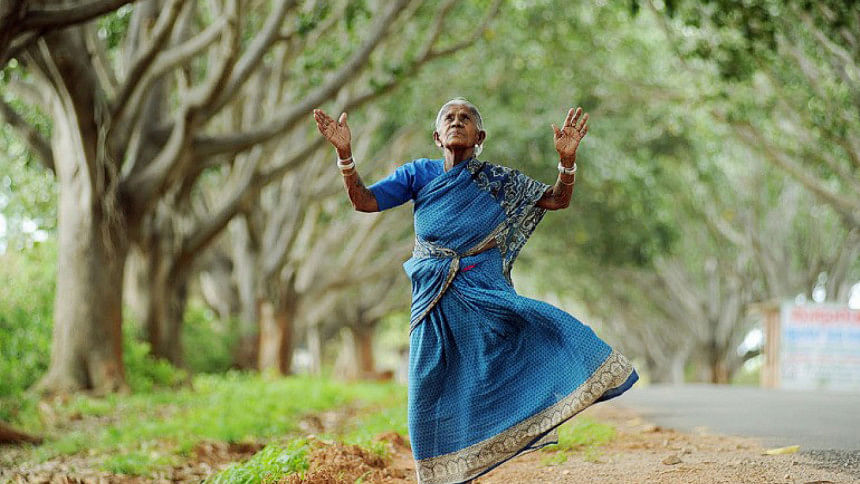The Mother of Trees

It is perhaps the greatest environmental love story of all. Saalumarada Thimmakka, a day labourer and Bekal Chikkayya, a cattle herder, both from Hulikal village in Bangalore district, defying all the taunts from society for being childless, decided to plant trees and treat them like their children. It may have seemed like the whim of an eccentric couple but they lived up to their promise taking care of the saplings of Banyan trees, sometimes carrying water for them a good four kilometres. They were, after all, their most beloved, their children, and over 50 years these saplings grew into gorgeous banyan trees, providing a wondrous 5 km canopy from Kudur to Hulikal. Although her beloved life partner passed away in 1991, Saalumarada, (now 105 apparently, has been awarded for her work), continued to raise her children - more than 380 of them in Karnataka.
Contrast this with the millions of trees being mercilessly cut every day all over the world to make fancy furniture or make way for the accommodation of an ever burgeoning population. In our own country, once known for its overwhelming greenness, around 2,000 hectares of forest are lost (says a 2009 FAO report) due to overpopulation, weak legislation and of course the mother of all evils, GREED. The loss must be many times more by now.
You don't even need statistics to know how much greenery we have lost. Just look out the window. If you are among the majority of the 17 millions of residents of this claustrophobic city, chances are all you will see is a skyline of concrete and more concrete, with maybe a smattering of something green here and there. In some areas, trees as old as a hundred or more have been leveled to the ground to make way for high rise apartment buildings, malls, parking lots or for rows of ugly shops selling hardware, sanitary ware, automobile spare parts and what not. This is the scene pretty much all throughout the urban areas of the country while villages have been denuded to accommodate smoke-emitting brick kilns. In hilly areas like the Chittagong Hill Tracts, hills have been butchered for human settlement, along with all the trees. And now the worst killing of all – the Sundarbans where mangroves will be brutally decimated to allow for a mammoth coal plant to spew out ash and for heavy industries to cough up their noxious fumes. Surely trees will die, along with them all those beings that depended on them. Humans, unfortunately, have started on a suicidal path, killing what can be described not as their children but rather their mothers who have all along sacrificed everything, to keep their wards alive.
For without the rows of trees in coastlines that shielded us from the monsters called Aila and Sidr, how will we be protected from their vicious onslaught that will drown our villages, our homes and ourselves? Who will provide the cooling shade and sustenance for weary travellers battered by the sweltering sun? And those of us who have forgotten to think beyond our Dhaka, how much thicker will the smog get as we get more and more cars on the streets, more air-conditioning for our greedy ventures? Who will inhale all the carbon monoxide and other noxious gases now that we have done away with all those Krishnachura, Bunyan, Rain Trees, Koroi, Mango and Jackfruit trees and those whose names we do not know, that once lined our streets? Now we must inhale the artificial venoms we have created and subject our young ones to wheezing lungs that may or may not survive the years of slow poisoning.
But it was not always so brutal, I might say to my grandchild (if I am lucky enough to live that long). Once upon a time we loved trees like our children. We planted saplings and watered them with utmost care. We had gardens in almost every home where the fragrance of Hasnahena, Gondhoraaj, Beli, Rajanigondha and Jasmine would intoxicate the evening breeze. They were havens for the children to climb those intricate networks of branches to get to the treasure of mouthwatering peara, jaam, tetul, aam, lichu, betphol, jamrul and boroi. The trees were in abundance in the streets, inside houses, in parks that have long gone extinct along with their green gems. Houses were decorated, not with shiny, gaudy steel, but with cascading bougainvillea of every shade – pink, fuchsia, yellow and fiery orange. There was oleander, magnolia, joba, dahlia, gada and shy periwinkle to create a fairy kingdom for butterflies and bees and tiny birds to find their nectars. And then when we got sick, there was the neem tree to provide leaves of soothing baths during chicken pox, the orhohor leaves to ease our jaundice.
Now all we can do is sigh with nostalgia for a time lost forever. Now we must drive for miles before we can escape the ugliness of the barren, concrete jungle we call home to find a few patches of green. Thankfully there are still some trees bravely standing tall, trying hard to take in the fumes emitted by our deadly contraptions, defiantly facing the lecherous eyes of those humans waiting for the opportune moment to strike and steal.
For some reason, the story of Salumaraada made me think of two guava trees in the house I once lived in. One was right in front near the gate and the other at the back leaning against an intermediary terrace. It was a special variety of guava – green on the outside and salmon coloured inside, the taste equally exquisite. They were my mother's favourite trees and she took great pleasure in picking them from the terrace and giving the treats to her children. But a few odd years later, one of the trees became visibly sick – perhaps it had been struck by lightning or its roots had been made weak by the storm. Perhaps it had caught some terminal disease. Right before my eyes, everything became black – the branches, the leaves, even the fruit. Soon its twin on the other side followed suit as if in grief for its lost mate. The death of those trees was a bewildering tragedy for us, especially my mother for whom trees always provided her solace. How I wish I had found Salumaraada then. She would have known how to keep these children of nature alive.
The writer is Deputy Editor, Editorial and Opinion, The Daily Star.

 For all latest news, follow The Daily Star's Google News channel.
For all latest news, follow The Daily Star's Google News channel. 



Comments